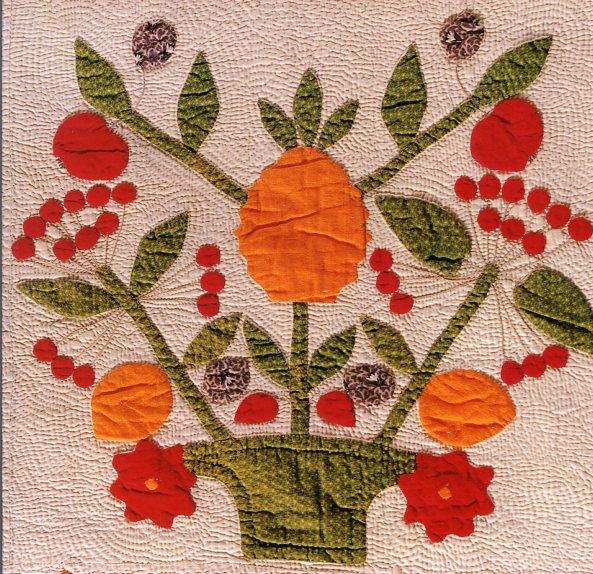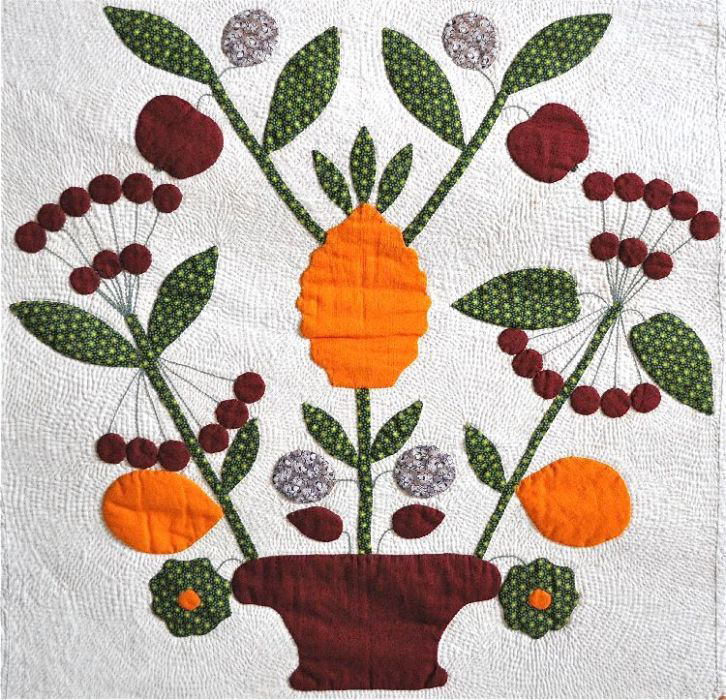BACK TO ESSAYS
Separated at Birth: Two Quilts from West Virginia
It was the only quilt Shelly showed me that day, and it was not for sale at the time. Shelly had recently purchased it from the estate of Sandra Mitchell, a prolific quilt collector and dealer who had just passed away. When Shelly pulled the box from under a bed and opened it, I was absolutely blown away. Thinking back to when I first saw the quilt, never in a million years did I think I'd own it one day, much less unlock the mystery behind its origins.

Album
Mary Couchman Small
Martinsburg, Berkeley County, West Virginia
c1850
Private Collection
I'd never seen a quilt with such dense quilting. The entire white space on the quilt was echo quilted in rows separated by 1/16th of an inch, and around 10 stitches per inch in each row. The appliqué fabric was all in mint condition, but wasn't quilted, giving it a raised effect. Fabrics included a fairly common over-dyed green floral print, a lavender floral print, a cheddar orange solid, and a deep brick red solid that some have called oxblood.
The quilt was featured in Shelly's 1995 book, American Quilt Collections: Antique Quilt Masterpieces - but at the time, none of us realized it had been misidentified after its separation from the family. The information was part of the entry for the Sandra Mitchell Collection, and the quilt was identified as a Pennsylvania Album from 1865, maker unknown.
In 2006, a series of very unlikely events led me to purchase the quilt. In 2009, I decided to post some pictures of it on my web site and bring it to show the Columbia Willamette Quilt Study Group (CWQSG). The group was very interested in the quilt, and CWQSG Coordinator Martha Spark thought it could have been made earlier than 1865 because of the level of detail.
Back in 1995, when Shelly published her book, the West Virginia Heritage Quilt Search was halfway through a ten-year-long, statewide quilt documentation project. The project culminated in 2000, with the release of West Virginia Quilts and Quiltmakers: Echoes from the Hills by Fawn Valentine.
I did not learn about the book until 2009, and it was just by chance - an unexpected, indirect result of my participation in the CWQSG meeting. After the meeting, Martha Spark was corresponding with Fawn Valentine and my quilt came up. When Fawn discovered the picture on my web site, she sent a note to Martha, which Martha forwarded to me.
Fawn and I started to correspond. She told me there was a quilt almost exactly like it in West Virginia, and felt my quilt had possibly been misidentified. The almost-identical quilt was in her book - that's when I learned about the book. It was difficult to accept that there could be anything like my quilt, but I thought maybe there would be some design references or other similarities. So, I ordered a copy of the book.

Album
Harriet Small
Martinsburg, Berkeley County, West Virginia
c1850
Private Collection
When the book arrived, I was floored. The image on the cover was basically identical to one of the baskets on my quilt. The quilting was the same, and I'd never seen that anywhere else before. The lack of quilting on the appliqué was also the same, but there was much more inside the book. On page 110-111, there is a full description with detail and full view photos of the album quilt, made by Harriet Small of Berkeley County, West Virginia in 1850.

This block is on the cover of West Virginia Quilts and Quiltmakers.

This block is from Volckening's quilt.
You could've knocked me over with a feather. I was absolutely stunned. Of the 25 individual block designs, 19 of them can be called a match. The block comparison (PDF) is available here: https://kora.quiltindex.org/files/26-135-1/BlockComparison.pdf.
The quilt also shares the same wandering vine borders, same lyre motif in the center block, and as mentioned, the same quilting and same lack of quilting in the appliqué. Six designs are unique to each quilt, and the level of sophistication varies from one quilt to the other.
Through a little genealogy research and more correspondence, I learned my quilt was made by Harriet's mother, Mary Couchman Small (1800-1863). The Small family had a farm in Martinsburg, Berkeley County - about 100 miles west of Baltimore - and it was a rare piece of flat, river bed land amidst more rugged terrain. The farm was located close to a main road, and is now occupied by a GM plant. Mary's daughter, Harriet, was born in 1836, which would've made her 14 years old around 1850. Mary would've been 50 at the time. According to one genealogy record, Harriet may have died shortly after 1850.
Family records indicate both quilts descended through the family of Harriet's sister, Elizabeth Jane Small Sperow, but around 1995, when West Virginia was documenting Harriet's quilt, the family couldn't lead the search team to Mary's quilt. There was a reference to the second quilt in a note sent by the family to Valentine, but no response to the request for pictures and more information. There's a good chance Sandra Mitchell had already bought Mary's quilt by then, and also possible that it was found in Pennsylvania, where descendants of the Sperow family resided.
To understand why this quilt was separated from its history, it's important to know a little more about Mitchell. The woman had an incredible eye for quilts. She was disliked by some, for being somewhat abrupt and disheveled looking, but was well loved by others. Julie Silber, who admiringly called Mitchell the "Queen of Cheddar" says "Sandra Mitchell was hard to miss...and hard to forget..."
One thing's for sure. Sandra Mitchell was shrewd. She was also a hoarder. When she died in 2000 at age 58, her affairs were very much in disarray. One source close to the estate liquidation called it a huge mess. Apparently, Mitchell collected all types of things including Cabbage Patch Dolls and quilts. I've tried to learn more about it, but have realized it may be one of those things you just don't speak of. It is unclear whether or not there was a will, but I suspect there wasn't.
In the last decade, many of Sandra Mitchell's quilts have surfaced on the open market and some are currently available. By the time I received Mary Couchman Small's quilt, it was well removed from its history, including the Sandra Mitchell estate liquidation. I was aware that it had once been part of Mitchell's collection, but all I really knew was what was printed in Shelly's book. I've learned a lot since then, and feel the separation between the two quilts happened unintentionally. It's possible Mitchell was not provided with the history, but if that history had only made it to Shelly, it would've been preserved in great detail.
This research has been a wonderful journey for me, so far. I learned the two quilts weren't really separated at birth in the literal sense. They were actually separated later in life. But in terms of shared characteristics, they were clearly from the same gene pool. From here, I hope to travel to West Virginia and view the two quilts together. There may be more information to be found in the local historical society, and from the family. AQSG Seminar attendees had an opportunity to see Harriet's quilt years ago when the Seminar was in West Virginia. I look forward to the opportunity to share Mary's quilt.
Bill Volckening
2011
All rights reserved
-
Documentation Project
The West Virginia Heritage Quilt Search West Virginia Department of Archives and History
-
ALBUM QUILT SMALL, HARRIET
-
c1850
Album Small, Mary Couchma...
Load More